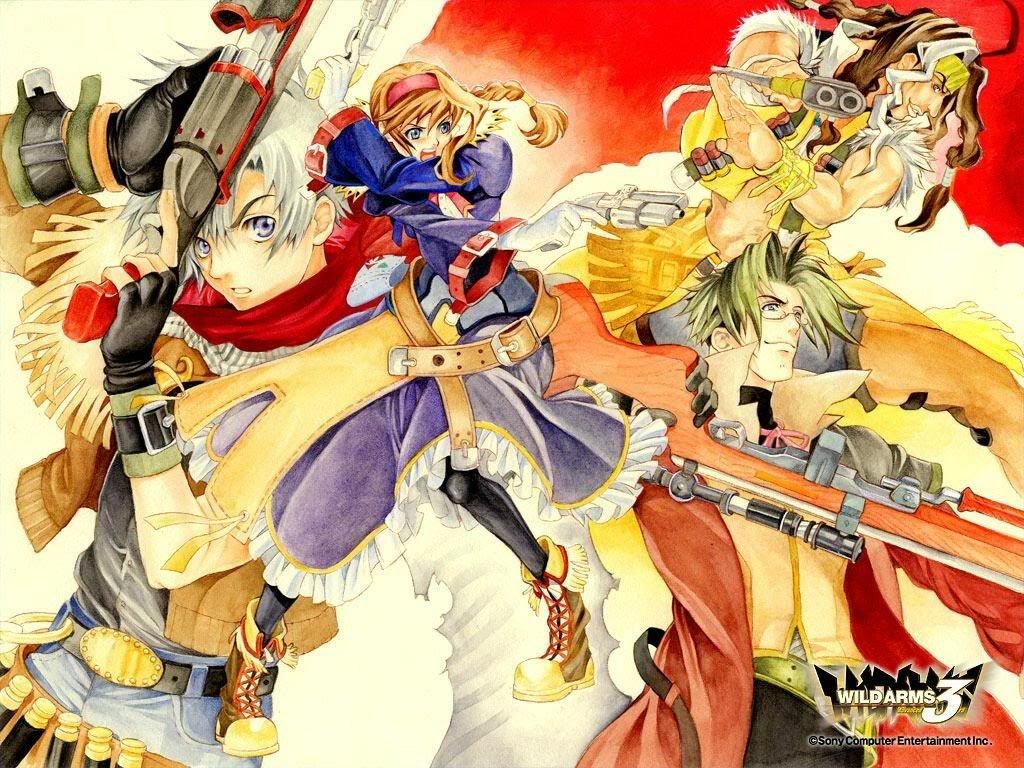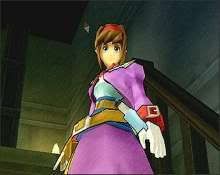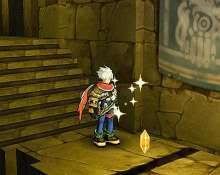At first I thought it was bold of Wild ARMS 3, a 2002 JRPG developed by Media Vision
for the PS2, to begin its story with such a cliched first line. Now I'm worried that this
might be horseshit, because 1) I doubt that Media Vision's translators understood that
they were even committing such a faux pas based on the dry writing of the rest of their
script, and 2) it's not even raining in the damn game.
Anyway, the text eventually fades away. Zoom in on a train chugging through a barren
wasteland in the dead of night. Our heroine, Virgina, is stirred awake by some sort of
commotion in the adjacent car. When she goes to investigate the precious cargo therein,
three mysterious Drifters jump into view from behind a crate, the opposite door and
through the window. Immediately all four of them pull their guns on each other.
Freeze frame. The player then chooses which character to play as.

For those who got Western blue balls from the first two games of the series, this sequence
was very encouraging. It seemed that the development team had finally watched at least
one movie set in the Old West. They didn't have to rely on their usually brilliant sound
composer Michiko Naruke to cop melodies from Ennio Morricone in order to fill in for
all of the Western motifs they had forgotten to insert. They understood that outlaws
wielded guns and not swords or magic wands and that people traveled great distances
via railroad and not by foot on a World Map screen. Even magic spells are now explained
as an extension of native mysticism rather than by the rites of nuns or vampires.
When you select one of the characters, you're treated to a playable flashback of how he or
she came to be on the train. The point of this prologue is to introduce you to the
mechanics of the game by having you play through four snappy little dungeons, one for
each character, each one very different from the other.
The one positive thing I can say about every Wild ARMS game, as far as I remember, is
that they all had fairly well-designed dungeons. Rather than just being a long series of
hallways to walk through while you fight monsters or fall asleep, most of the dungeons
in Wild ARMS 3 actually have puzzles to solve, traps to evade, you know, things for you
to do. The interesting thing is that some of the puzzles can only by solved through the
use of magical tools only in the possession of your party. It's the moments when you
solve these puzzles, when a door opens because you put out a torch with your snowman
plush-doll that shoots freezing laser beams, when you believe that you are the first to
plunge the depths of these ruins not just because you are so smart but because they
were waiting for you.



At the end of each prologue dungeon is a boss. Each boss has some sort of trick up
its sleeve - some can heal themselves, one is highly evasive and one can multiply itself.
The only way to overcome these trials is by taking advantage of each character's talent,
usable with enough FORCE POINTS, a gauge that builds up whenever damage is dealt,
received or evaded, kind of like the power gauge in a fighting game. A healing foe can
be dealt with by using Accelerator, which allows Jet to act before all others. An evasive
foe can be felled with Lock-On, which allows Clive to deal 100% un-dodgable damage.
Multiple foes can be eliminated all at once with Extension, which allows Gallows to
target all enemies at once. All of these battles set up the expectation that future fights
will have to be won with the utilization of these techniques and not just with brute
force alone.
Back in the present, the precious cargo that was supposed to be in the chest in the
freight car is revealed to have been stolen by a trio of drifters who have fled to the roof.
Our four heroes go after them and have a little boss fight atop the speeding train.
They retrieve the priceless ARK SCEPTER and Gallows convinces everyone to help
him return it to his hometown, the village of the Baskar People.
It's there that they all get mystic powers and are saddled with a destiny that says that
they will - probably - have to save the world from an encroaching evil.
Huh? So we've gone straight from a handful of character who all had their different
personal reasons for heading out into the wasteland to a single unit that only has the
word of one NPC to believe that they have a good reason for going anywhere together?
Let's take a look at these guys: Jet (white hair) is a brooding amnesiac. Clive (with the bill)
is such a clinical observer that he's not that cool, despite carrying a huge rifle and looking
like Citan Uzuki, the most badass family man in any video game. Virginia (flower holsters)
is such a naive Pollyanna. Gallows (curry rice and tempura) is a lush who ditches his
family and runs away from his duties as a priest-in-training. Gallows is the most
sympathetic character because he actually behaves like a real human being.

The game would have us believe that these guys' sticking together is what we should
want because that's what our purported protagonist Virginia seems to want. It would
have been interesting to have seen Virginia's need for traveling companions extending
from her fear of being alone, a fear possibly originating from her mother dying and
her father leaving her when she was young. Instead, she just says that it's the right
thing to do.
Clive and Gallows sympathize with her viewpoint rather easily, but Jet the Amnesiac
Loner says that he'd rather split and not be held back by a bunch of wannabe drifters.
Virginia shows some cajones when she finally shoves Jet's "I'm a loner who works
alone" bullshit right back in his face when she asks him to name a single thing he's
ever done on his own that was worthwhile.
See, that's part of the problem, though. If I were to believe Jet as a misanthrope, he'd
say, "Well, fuck you," and leave the party right then. As ensembles go, the cast of Wild
ARMS 3 doesn't have much chemistry. The only thing keeping these characters
together, and the only reason the kid is in charge, really, is because the story would
end otherwise.
The cast of a JRPG is a funny thing. First you've got to put all the characters into a
situation where they HAVE to work together, and then you have to develop them until
they believably WANT to work together. Wild ARMS 3 shoots itself right in the foot
with its fancy new six-shooter by having the characters admit, before their objective is
even defined, that they have no reason to travel together.
This coalescence of playable characters is much different from the cast of the unfairly
maligned Wild ARMS 4, in which our young hero liberates a girl from the hands of an
evil empire with the help of her would-be captor, all of whom implore the help of an
older and stronger drifter in evading their pursuers. From the start all of our
protagonists are united by their opposition to the antagonists, forgoing the old JRPG
trope of never revealing the villain until the second or even third act of the game in
favor of a more defined, believable story.
Until Wild ARMS 4, though, Media Vision was perfectly comfortable having their heroes
putter around the wasteland, reluctantly agreeing to find meaningless treasure based on
vague clues from townsfolk.
I was about to describe the townsfolk as "faceless" until I realized that, actually, Wild
ARMS 3 might be one of the few RPGs in which every NPC has a name and a character
portrait. Considering everything else the team missed, it's funny to see such detail.
I'd also like to take this moment to explain something I NEVER noticed the first time I
played this game was what happens when you choose to discontinue your game after
saving, because I always just turned it off. You're treated to a little song set to character
illustrations and your party's stats, including total play time, number of saves, etc. It's
like the credits and the end of a TV episode. Between this and the opening animation
that changes depending on how far into the game you are, it seems like it was trying to
be an anime.
It's so weird to see so many little good ideas in this game. Dungeons are still a delight to
explore and every once in a while there's a boss battle that is just difficult enough to
allow the combat system to unfold its mechanics like a blossoming flower. But frankly,
a stronger narrative would've held all of the parts together.
We'll see how much farther I care to go in this game.
2 comments:
So what you're saying is that you have absolutely no goddamn clue about what constitutes a rich and rewarding story, and a likable, singular cast led by a fantastic protagonist of rare quality and depth.
Is this a spambot? The observations are vague, so probably. If not, you can check my newer game observations at my new blog which I think is going a lot better. Thank you.
Post a Comment